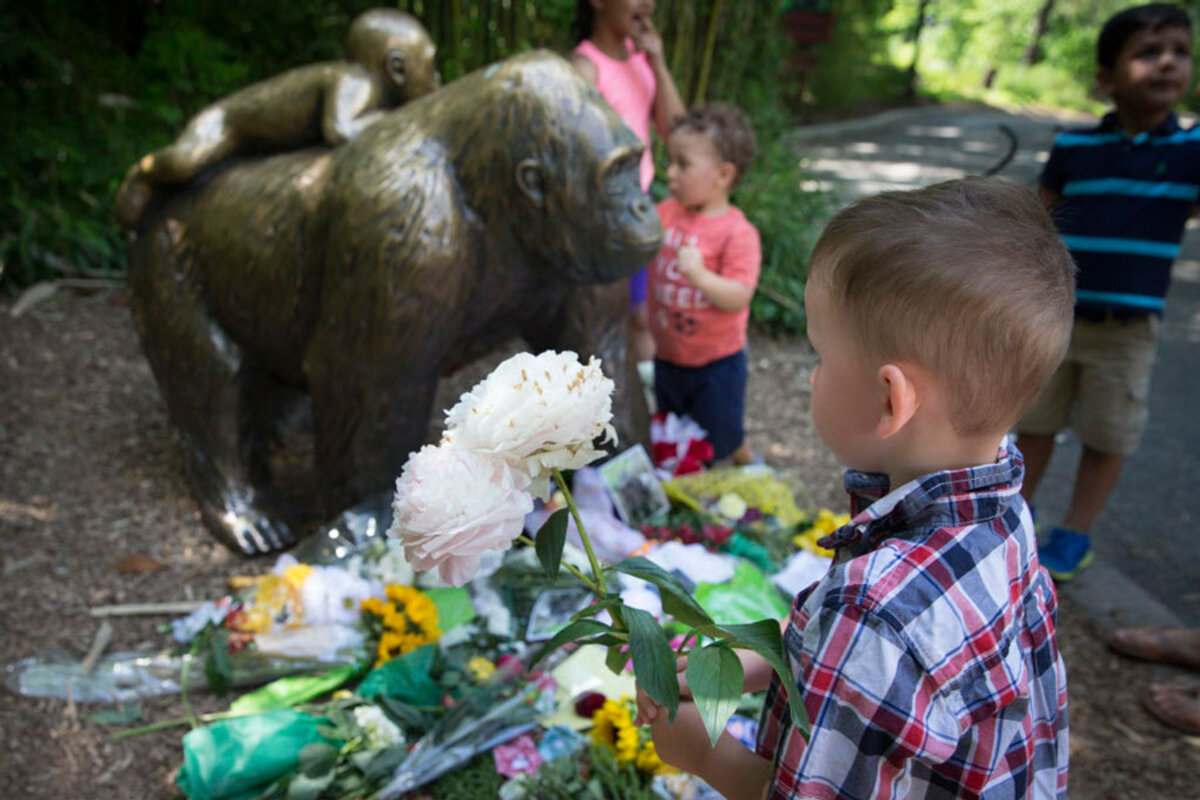After Harambe the gorilla shooting, how best to protect endangered species?
Loading...
A 400-pound silverback gorilla was shot and killed at the Cincinnati Zoo and Botanical Garden on Saturday after a little boy fell into the animalâs enclosure.
Zoo officials said they made the "difficult" decision because the gorilla, a 17-year-old named Harambe, was acting erratically toward the child and seemed agitated by the cries of onlookers.
The tragedy ignited a public outcry over the weekend, with both zoo officials and the childâs parents blamed for the death of Harambe. But for some experts, the incident raised more important questions about the role of zoos more generally in preserving and rebuilding endangered species.
âPlaying the blame game just isnât going to get us anywhere,â says Marc Bekoff, renowned ethologist and a fellow for the Animal Behavior Society.
Harambeâs death has come amid a climate of heightened public interest in how humans treat animals â both in captivity and in the wild. A shifting understanding in the United States about the needs of individual animals, stoked by documentaries such as âAn Apology for Elephantsâ and âBlackfish,â have caused organizations such as Ringling Bros. and Barnum & Bailey Circus and SeaWorld to back away from showcasing large mammals as entertainment. Wildlife poaching, meanwhile, has become afor celebrities and governments.
The role of zoos is a more complicated topic, however. On the one hand, they keep animals in captivity. On the other, they promote worldwide conservation efforts and work to preserve critically endangered species, like the western lowland gorilla. The question for some ethicists is whether the resources being spent to house and care for animals would be better spent supporting populations in the wild.
âThe real issue weâre talking about is whether or not weâre justified keeping gorillas in captivity ongoing, and my argument is no,â says Lori Gruen, a professor of philosophy and co-coordinator of Wesleyan Animal Studies at Wesleyan University in Middletown, Conn. âWe should be taking the best care of captive gorillas, but [also] providing support for wild gorillas to live out their lives in the wild.â
Many zoos are already doing both these things, however, including the Cincinnati Zoo. The zoo says it has been funding gorilla conservation projects in the  among other initiatives, including a cell phone recycling project aimed at reducing demand for coltan, a mineral used in cell phones that is mined in gorilla habitat.
The nonprofit (AZA), which accredits and sets guidelines for zoos around the country, argues that zoos play a vital role in educating visitors about wild animals and conservation issues.
"Western lowland gorillas are critically endangered animals, so anything that can be done to help conserve their species must be done at this point. AZA-accredited zoos play an important role in that effort not only through the Species Survival Plan program, but also through supporting field conservation work," says Rob Vernon, communications director of the AZA, in an e-mail. "Between 2010 and 2014, AZA members contributed over $4.5 million to gorilla field conservation work. Gorillas are also one of the 10 signature species part of the SAFE: Saving Animals From Extinction effort that AZA members and partners are combining resources and leadership to save these great apes."
Researchers affiliated with the Lincoln Park Zoo in Chicago are leading in the Goualougo Triangle, a remote region of the Republic of Congo. The Bronx Zoo has raised for conservation programs through admission fees to its Congo Gorilla Forest, a 6.5-acre rain forest that is home to about 20 western lowland gorillas.
None of that good work helped Harambe, however, says Professor Gruen.
âWhy are we in a situation in which the choice has to be made between a highly endangered animal and a 4-year-old child?â she says. âItâs only because we have a highly endangered animal in zoo setting, otherwise the choice wouldnât have to be made.â
Harambe was brought to the Cincinnati Zoo in 2015 to breed with other gorillas, but she notes that, since gorillas bred in captivity can never be released into the wild, expanding captive gorilla populations will do nothing to help wild gorillas under threat from poaching and habitat loss and fragmentation.
âWeâre engaged in a process where weâre going to perpetuate captive gorilla populations that will never be able to returned to wild,â she says.
âThe idea that gorillas are somehow ambassadors to the wild and will someday return, thatâs not correct,â she adds. âThe goal should be to provide the best captive care for gorillas âĶ and protecting and preserving wild gorillas.â
Reformers instead say that zoos should follow an increasingly popular âcompassionate conservationâ approach that uses large sanctuaries, strictly limiting human interaction, to focus on rehabilitation.
âWe tried to build something more enriched â a happy resting ground for all of [these animals],â Ed Stewart, who co-founded one such sanctuary in California, told the Monitor in February. âBut itâs still a step way down from the wild.â
Animal ethicists say they hope that the public continues to ask questions about how best to protect and care for endangered species in the wake of the weekend tragedy in Cincinnati.
âTo me the major question is: Why was Harambe there in the first place?â says Dr. Bekoff, a former professor of ecology and evolutionary biology at the University of Colorado, Boulder. âWe canât bring Harambe back, and Iâm thrilled the boy is safe, but I was hoping this case would make a difference, and I think it is a case that will make a difference.â





